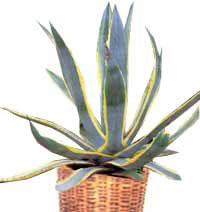Agave / Agave
Refers to the family of agave Fatherland - South America and the south of North America.
General description : It has more than 50 species, but because of the large size, only dwarf forms or seedlings are suitable for rooms.
The most common is Agave victoriae-reginae (Queen Victoria's Agave). Leaves are gray-green in color, narrow and long, hard, at the ends of brown tapering. At the edges of the leaves are thin, snow-white, easily peeling strips.
Blooms yellowish apical rosettes of a spherical shape.
A larger species of Agave americana (Agave americana). The forms differ in the color of the leaves: A.mediopicta - leaves with a wide yellow stripe in the middle, A. marginata - leaves with bright yellow edges.
The leaves have brown tips in the form of teeth, a bulge on the underside. They can grow to a length of more than a meter. Huge and similar inflorescence (in some cases more than 10 m), owns the shape of panicle. It blossoms once in a lifetime, about the fifteenth year, after flowering it dies, but leaves the layers.
Recommendations for the care of Agava plant :
Illumination: Photophilous, gives preference to southern windows, especially in winter. Summer loves the fresh atmosphere on the sunny side. With a flaw in the light, the leaves thin out. Because of its large size, it is difficult to place it on the windowsill. The output is found in additional artificial light.
Irrigation regime: Summer is moderate. In winter, if there is no way to provide cool air, watered by the measure of drying the soil. In the cool water once a week. Overflow can be fatal, especially if there is no drainage.
Humidity: Requires periodic spraying, especially in winter, if the atmosphere is above 15 ° C. Extremely low humidity of the atmosphere contributes to the appearance of a spider mite.
Temperature mode: In winter it can carry the temperature up to 4 ° C. In the warm season, the usual temperature regime.
Soil: Mandatory drainage. It is allowed to add to the ground a broken scarlet brick, birch charcoal. Recommended soil mix: 3 elements of clay-turf ground, 1 share of leaf land and 1 part of sand. It will be useful to add a brick crumb () and pieces of birch coals. In the warm season, every three to four weeks requires additional fertilizing. Like fertilizers for succulents and cacti.
Breeding: With cuttings, cuttings or seeds.
Transplant: Young - every year in the spring, mature - once a couple or three years.
Pests: It is infrequent.


Good for rooms is the Agave filifera (Agave Nitenosa), named so because of filiform endings on the leaves.
Agave parviflora (Agave small-flowered) because of its compactness seems to be ideal for breeding.
Agave filifera
Agave parviflora


Comments
Commenting on, remember that the content and tone of your message can hurt the feelings of real people, show respect and tolerance to your interlocutors even if you do not share their opinion, your behavior in the conditions of freedom of expression and anonymity provided by the Internet, changes Not only virtual, but also the real world. All comments are hidden from the index, spam is controlled.